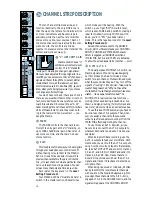
10
L
MONO
L
MONO
L
MONO
L
MONO
LINE IN 7–8
R
R
R
R
LINE IN 9–10
LINE IN 11–12
LINE IN 13–14
BAL
OR
UNBAL
BAL
OR
UNBAL
BAL
OR
UNBAL
BAL
OR
UNBAL
LINE IN 3
LINE IN 4
L
R
1
2
1
2
RIGHT
AUX SEND
STEREO AUX RETURNS
MAIN OUTS
LOW CUT
75 Hz
18dB/OCT
LOW CUT
75 Hz
18dB/OCT
BAL
OR
UNBAL
BAL
OR
UNBAL
LINE IN 5
LOW CUT
75 Hz
18dB/OCT
BAL
OR
UNBAL
LINE IN 6
LOW CUT
75 Hz
18dB/OCT
BAL
OR
UNBAL
LINE IN 1
LINE IN 2
MIC
1
MIC
2
MIC
3
MIC
4
LEFT
(1/MONO)
BAL/UNBAL
LOW CUT
75 Hz
18dB/OCT
LOW CUT
75 Hz
18dB/OCT
BAL
OR
UNBAL
BAL
OR
UNBAL
ALL BAL/UNBAL
MIC
5
MIC
6
TRIM
TRIM
TRIM
TRIM
TRIM
TRIM
LEVEL
+4
-10
-10
-10
-10
LEVEL
+4
LEVEL
+4
LEVEL
+4
TRIM
TAPE
INPUT
TAPE
OUTPUT
L
R
MIC
GAIN
U
+10dB -40dB
-
10dBV
10
60
MIC
GAIN
U
+10dB -40dB
-
10dBV
10
60
MIC
GAIN
U
+10dB -40dB
-
10dBV
10
60
MIC
GAIN
U
+10dB -40dB
-
10dBV
10
60
MIC
GAIN
U
+10dB -40dB
-
10dBV
10
60
MIC
GAIN
U
+10dB -40dB
-
10dBV
10
60
MS1402-VLZ PATCHBAY DESCRIPTION
At the risk of stating the obvious, this is
where you plug everything in: microphones,
line-level instruments and effects, head-
phones, and the ultimate destination for your
sound: a tape recorder, PA system, etc.
MIC INPUTS (Channels 1–6)
We use phantom-powered, balanced micro-
phone inputs just like the big studio
mega-consoles, for exactly the same reason:
This kind of circuit is excellent at rejecting
hum and noise. You can plug in almost any
kind of mic that has a standard XLR-type male
mic connector.
To learn how signals are
routed from these inputs:
. If you wire your
own, connect them like this:
2
2
3
1
1
SHIELD
COLD
HOT
SHIELD
COLD
HOT
3
SHIELD
COLD
HOT
3
2
1
Pin 1 = Ground or shield
Pin 2 = Positive (+ or hot)
Pin 3 = Negative (– or cold)
Professional ribbon, dynamic and condenser
mics will all sound excellent through these in-
puts. The MS1402-VLZ’s mic inputs will handle
any kind of mic level you can toss at them,
without overloading. Be sure to perform the
Level Setting Procedure
: .
PHANTOM POWER
Most modern professional condenser mics
are equipped for Phantom Power, which lets
the mixer send low-current DC voltage to the
mic’s electronics through the same wires that
carry audio. (Semi-pro condenser mics often
have batteries to accomplish the same thing.)
“Phantom” owes its name to an ability to be
“unseen” by dynamic mics (Shure SM57/SM58,
for instance), which don’t need external power
and aren’t affected by it anyway.
The MS1402-VLZ’s phantom power is glo-
bally controlled by the
PHANTOM
switch on
the rear panel .
Never plug single-ended
(unbalanced) micro-
phones or instruments
into the
MIC IN
jacks if the
PHANTOM
power
is on.
Do not plug instrument outputs into the
MIC IN
jacks with
PHANTOM
power on unless
you know for certain it is safe to do so.











































